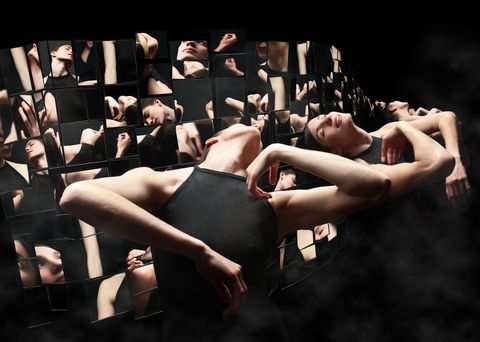
Former dancer Kyle Froman didn’t just spend 14 years gracing the stage for the New York City Ballet, which is a very demanding job in itself—he also developed a serious secondary talent along the way, photographing life from the wings at every chance he could get. His interest in photography has since developed into his full-time gig, with his keen eye for grace and movement earning him a publishing deal for his first book, In the Wings: Behind the Scenes of the New York City Ballet. Froman’s latest collection of photos is currently on display at acclaimed summer dance festival Jacob’s Pillow; entitled “Bodies/Buildings,” the work likens the stature of Froman’s ballerina subjects to architecture, illustrated quite literally in dramatically composed photos. Here, he offers us a look at some of his select favorites, as well as the film by Ezra Hurwitz that documents his artistic journey.
“The choreography of ballet reminds me of a building,” Froman says. “There’s a structure to it, a framework. Instead of steel beams, dancers unify with choreography; individuals become a combined whole. The steps of the ballet are set, but the dancers have a degree of freedom in how they interpret them. They can dance the same ballet differently every show, playing with the musicality, the intention behind certain steps. It’s a lot like an architect adding personal style to a conventionally built building.”
It was 2009 when Froman decided to trade one creative career for another. “The former principal dancer Nikolaj Hübbe had just taken over as director of the Royal Danish Ballet in Copenhagen, and he invited me to fly to Denmark and create a photo booklet that was to accompany a Balanchine program the company was presenting,” he recalls. “However, I was supposed to be dancing with City Ballet at the Kennedy Center on a tour to Washington. I took stock of my career: I had danced with City Ballet for the last 14 years, and had done most of what I was going to do with the company. And I had this exciting passion for photography that had built up inside of me. I met with Peter Martins and retired from the company. It was obviously a bittersweet moment for me—I remember crying a lot as I said goodbye to different ballets. But it was a great decision in retrospect. I’ve been shooting ballet, Broadway, and fashion virtually non-stop since then.”
My previous life as a dancer completely informs how I photograph,” Froman says. “For my Broadway and dance photography, I can easily put myself into the performer’s shoes and translate that energy through my images. For my fashion photography, I’m comfortable shooting movement, and I feel I bring the theatricality of the stage to my images.”
The inspiration to capture moments backstage—subsequently launching a hobby, and then another career—came from the photographer’s realization that the audience was only seeing one facet of a very complicated story. “I remember thinking on more than one occasion before the curtain went up that if the audience knew what had been going on backstage all day, they wouldn’t believe it,” he says. “I felt that if they could take a peek behind the scenes, it would make the performance they were seeing that much more amazing. Dancers are people after all, and the demands of dancing in the New York City Ballet take their toll. The company does roughly 50 ballets per eight-week season, so that takes grueling hours of rehearsals. Plus, there are the hours spent taking class to stay in optimal shape and stops in the physical therapy room to either ward off injuries or just get through that evening’s performance. All those things, combined with the biggest stress—competing with 90 of the most talented dancers in the country…it’s quite a feat.”
Froman hasn’t entirely left his life as a dancer behind—in fact, he says it’s key to his aesthetic as a photographer. “That feeling of objectifying my body as I gazed into a mirror is very similar to looking through the viewfinder of a camera,” he says. “There’s a sense of unreality to both, and a kind of separation from the world. I’m much gutsier when I have a camera in my hand than when I don’t. And I’ll go after a shot until I get it. I feel like I’m choreographing the image in the viewfinder until the picture is how I envisioned it.
Also, when I’m ‘in the zone’ when I’m shooting, it’s just like when I danced. The left side of my brain turns off, and the creativity of the right side takes over. I stop analyzing and end up following my gut.”
“I feel I’ve captured a winning image when the shot haunts me afterwards—when I can discover new things about the shot every time I look at it.”
As for what’s next, Froman has his sights set on the fashion world—and we have a feeling we’ll be seeing much more of him. “I feel like I have a style that crosses over the different worlds that I shoot, and I get a thrill seeing how one world influences how I shoot another,” he says.” I think I bring a sense of glamour to my dance images and an energy to my fashion pictures. I also love how creative fashion photography can be. With ballet, there’s definitely a right and wrong as far as the dancer’s position. I think starting my photography career shooting dance, where the correct shot happens in a millisecond, toughened me up. When I shoot fashion, I feel free.”
By Elle







